FY021 Module: Report on Motivational Theories for Tesco's Jack Store
VerifiedAdded on 2020/11/12
|8
|1624
|112
Report
AI Summary
This report examines motivational theories applicable to Tesco's new discount store, Jack, to enhance employee productivity and align with the company's goals. It analyzes Maslow's need hierarchy theory, Vroom's expectancy theory, and Herzberg's two-factor theory, detailing their advantages, limitations, and practical applications within the retail environment. The report emphasizes the importance of understanding employee needs, providing appropriate rewards, and creating a satisfying work environment to boost morale and achieve organizational objectives. It concludes by highlighting the significance of motivation for business success and the practical guidance provided by these theories for effective management.

FY021
Paraphrase This Document
Need a fresh take? Get an instant paraphrase of this document with our AI Paraphraser
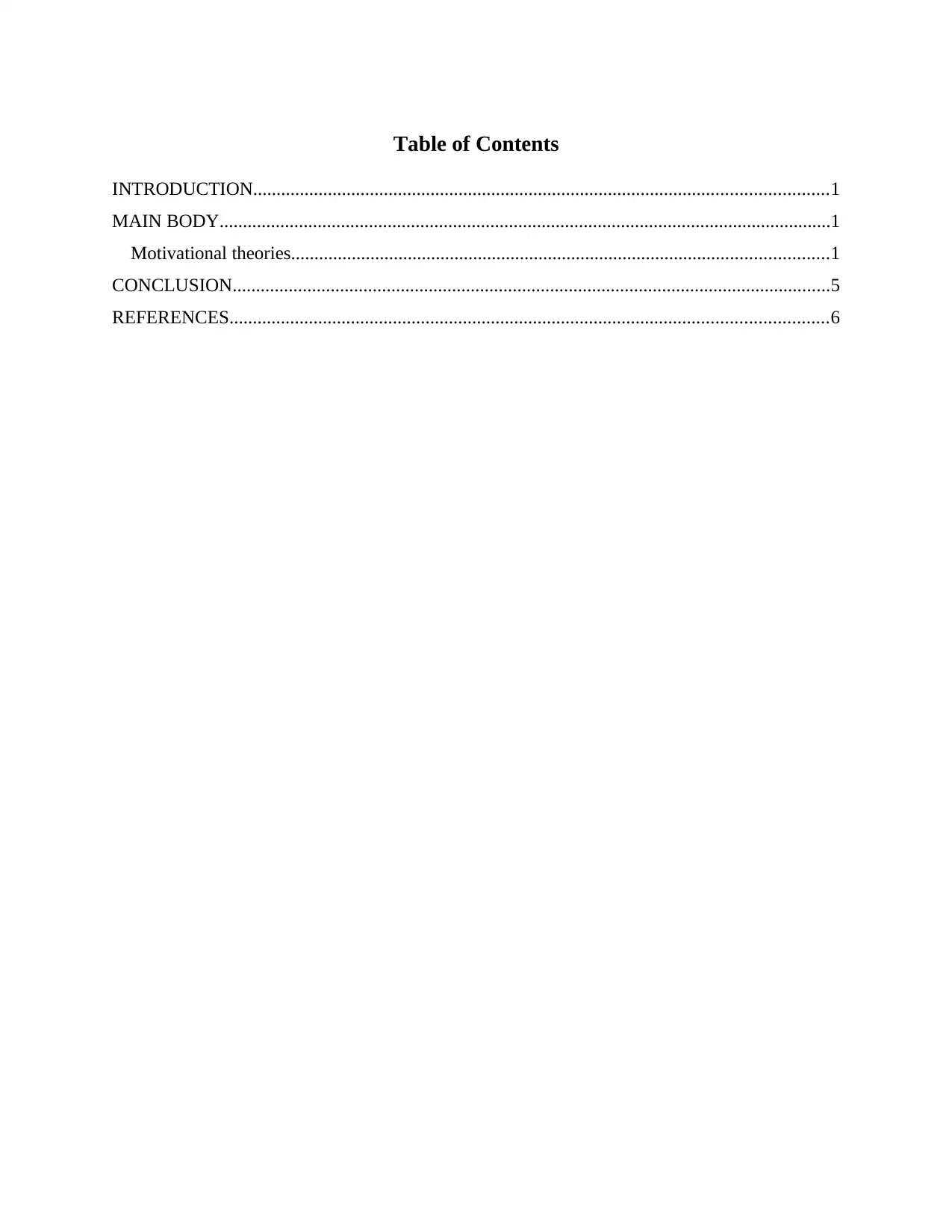
Table of Contents
INTRODUCTION...........................................................................................................................1
MAIN BODY...................................................................................................................................1
Motivational theories...................................................................................................................1
CONCLUSION................................................................................................................................5
REFERENCES................................................................................................................................6
INTRODUCTION...........................................................................................................................1
MAIN BODY...................................................................................................................................1
Motivational theories...................................................................................................................1
CONCLUSION................................................................................................................................5
REFERENCES................................................................................................................................6
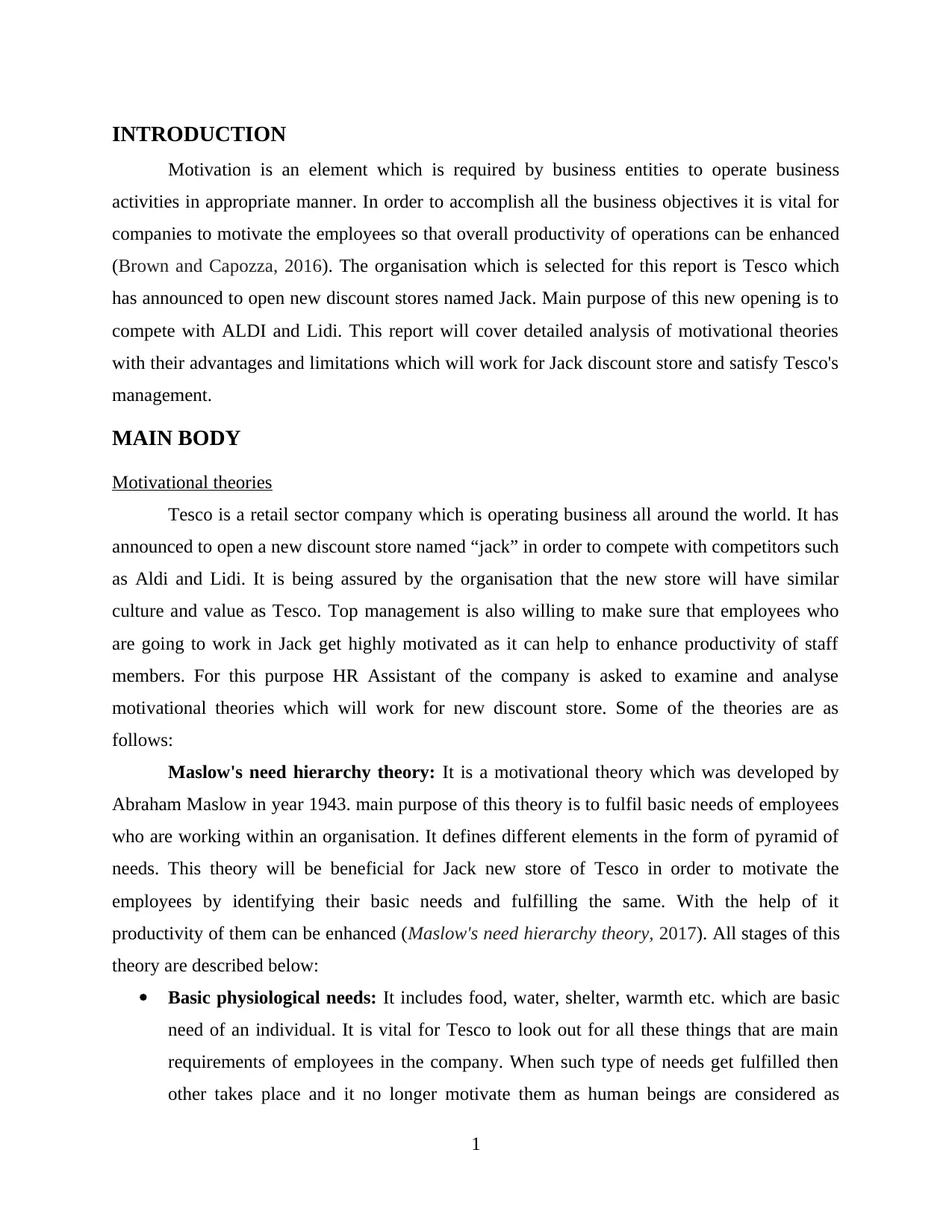
INTRODUCTION
Motivation is an element which is required by business entities to operate business
activities in appropriate manner. In order to accomplish all the business objectives it is vital for
companies to motivate the employees so that overall productivity of operations can be enhanced
(Brown and Capozza, 2016). The organisation which is selected for this report is Tesco which
has announced to open new discount stores named Jack. Main purpose of this new opening is to
compete with ALDI and Lidi. This report will cover detailed analysis of motivational theories
with their advantages and limitations which will work for Jack discount store and satisfy Tesco's
management.
MAIN BODY
Motivational theories
Tesco is a retail sector company which is operating business all around the world. It has
announced to open a new discount store named “jack” in order to compete with competitors such
as Aldi and Lidi. It is being assured by the organisation that the new store will have similar
culture and value as Tesco. Top management is also willing to make sure that employees who
are going to work in Jack get highly motivated as it can help to enhance productivity of staff
members. For this purpose HR Assistant of the company is asked to examine and analyse
motivational theories which will work for new discount store. Some of the theories are as
follows:
Maslow's need hierarchy theory: It is a motivational theory which was developed by
Abraham Maslow in year 1943. main purpose of this theory is to fulfil basic needs of employees
who are working within an organisation. It defines different elements in the form of pyramid of
needs. This theory will be beneficial for Jack new store of Tesco in order to motivate the
employees by identifying their basic needs and fulfilling the same. With the help of it
productivity of them can be enhanced (Maslow's need hierarchy theory, 2017). All stages of this
theory are described below:
Basic physiological needs: It includes food, water, shelter, warmth etc. which are basic
need of an individual. It is vital for Tesco to look out for all these things that are main
requirements of employees in the company. When such type of needs get fulfilled then
other takes place and it no longer motivate them as human beings are considered as
1
Motivation is an element which is required by business entities to operate business
activities in appropriate manner. In order to accomplish all the business objectives it is vital for
companies to motivate the employees so that overall productivity of operations can be enhanced
(Brown and Capozza, 2016). The organisation which is selected for this report is Tesco which
has announced to open new discount stores named Jack. Main purpose of this new opening is to
compete with ALDI and Lidi. This report will cover detailed analysis of motivational theories
with their advantages and limitations which will work for Jack discount store and satisfy Tesco's
management.
MAIN BODY
Motivational theories
Tesco is a retail sector company which is operating business all around the world. It has
announced to open a new discount store named “jack” in order to compete with competitors such
as Aldi and Lidi. It is being assured by the organisation that the new store will have similar
culture and value as Tesco. Top management is also willing to make sure that employees who
are going to work in Jack get highly motivated as it can help to enhance productivity of staff
members. For this purpose HR Assistant of the company is asked to examine and analyse
motivational theories which will work for new discount store. Some of the theories are as
follows:
Maslow's need hierarchy theory: It is a motivational theory which was developed by
Abraham Maslow in year 1943. main purpose of this theory is to fulfil basic needs of employees
who are working within an organisation. It defines different elements in the form of pyramid of
needs. This theory will be beneficial for Jack new store of Tesco in order to motivate the
employees by identifying their basic needs and fulfilling the same. With the help of it
productivity of them can be enhanced (Maslow's need hierarchy theory, 2017). All stages of this
theory are described below:
Basic physiological needs: It includes food, water, shelter, warmth etc. which are basic
need of an individual. It is vital for Tesco to look out for all these things that are main
requirements of employees in the company. When such type of needs get fulfilled then
other takes place and it no longer motivate them as human beings are considered as
1
⊘ This is a preview!⊘
Do you want full access?
Subscribe today to unlock all pages.

Trusted by 1+ million students worldwide
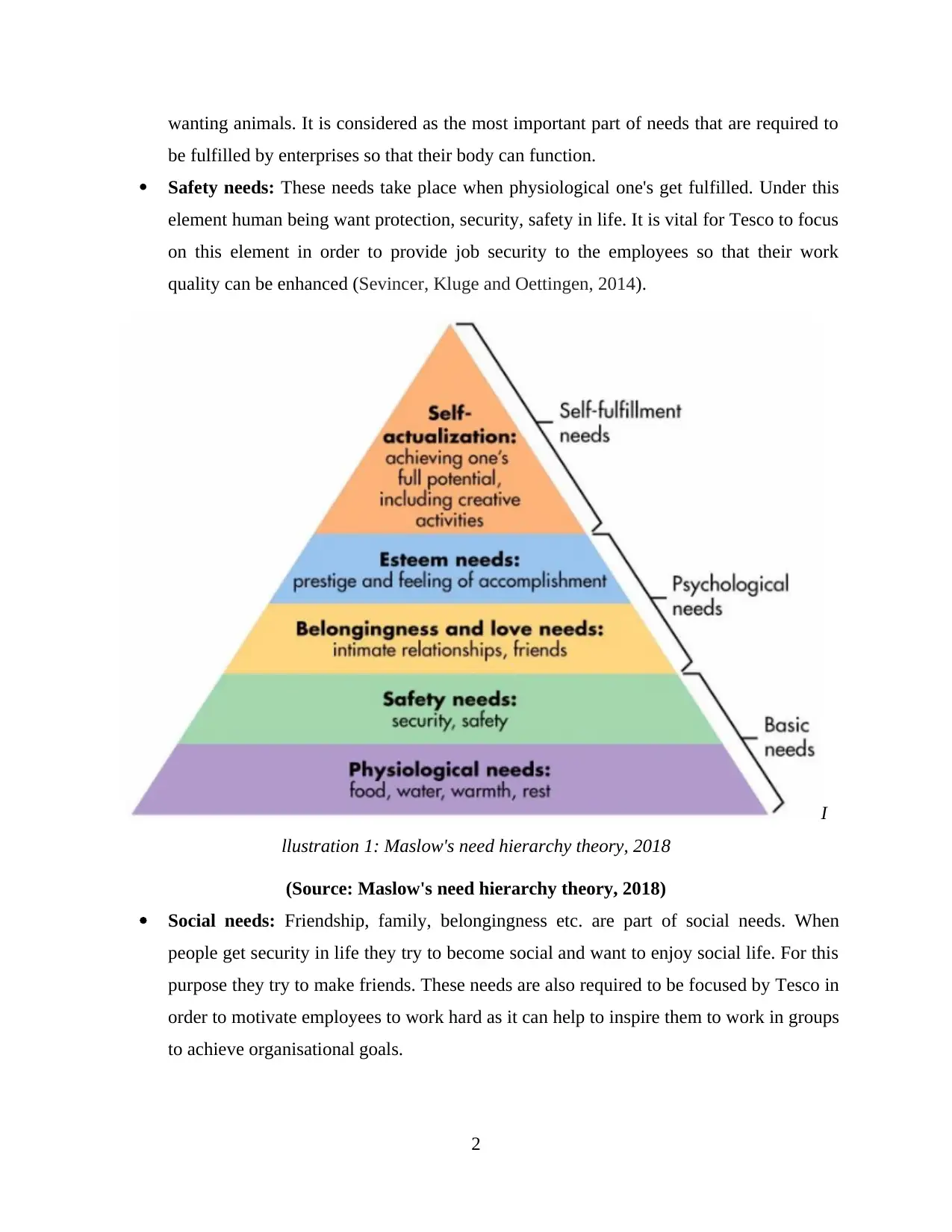
wanting animals. It is considered as the most important part of needs that are required to
be fulfilled by enterprises so that their body can function.
Safety needs: These needs take place when physiological one's get fulfilled. Under this
element human being want protection, security, safety in life. It is vital for Tesco to focus
on this element in order to provide job security to the employees so that their work
quality can be enhanced (Sevincer, Kluge and Oettingen, 2014).
I
llustration 1: Maslow's need hierarchy theory, 2018
(Source: Maslow's need hierarchy theory, 2018)
Social needs: Friendship, family, belongingness etc. are part of social needs. When
people get security in life they try to become social and want to enjoy social life. For this
purpose they try to make friends. These needs are also required to be focused by Tesco in
order to motivate employees to work hard as it can help to inspire them to work in groups
to achieve organisational goals.
2
be fulfilled by enterprises so that their body can function.
Safety needs: These needs take place when physiological one's get fulfilled. Under this
element human being want protection, security, safety in life. It is vital for Tesco to focus
on this element in order to provide job security to the employees so that their work
quality can be enhanced (Sevincer, Kluge and Oettingen, 2014).
I
llustration 1: Maslow's need hierarchy theory, 2018
(Source: Maslow's need hierarchy theory, 2018)
Social needs: Friendship, family, belongingness etc. are part of social needs. When
people get security in life they try to become social and want to enjoy social life. For this
purpose they try to make friends. These needs are also required to be focused by Tesco in
order to motivate employees to work hard as it can help to inspire them to work in groups
to achieve organisational goals.
2
Paraphrase This Document
Need a fresh take? Get an instant paraphrase of this document with our AI Paraphraser
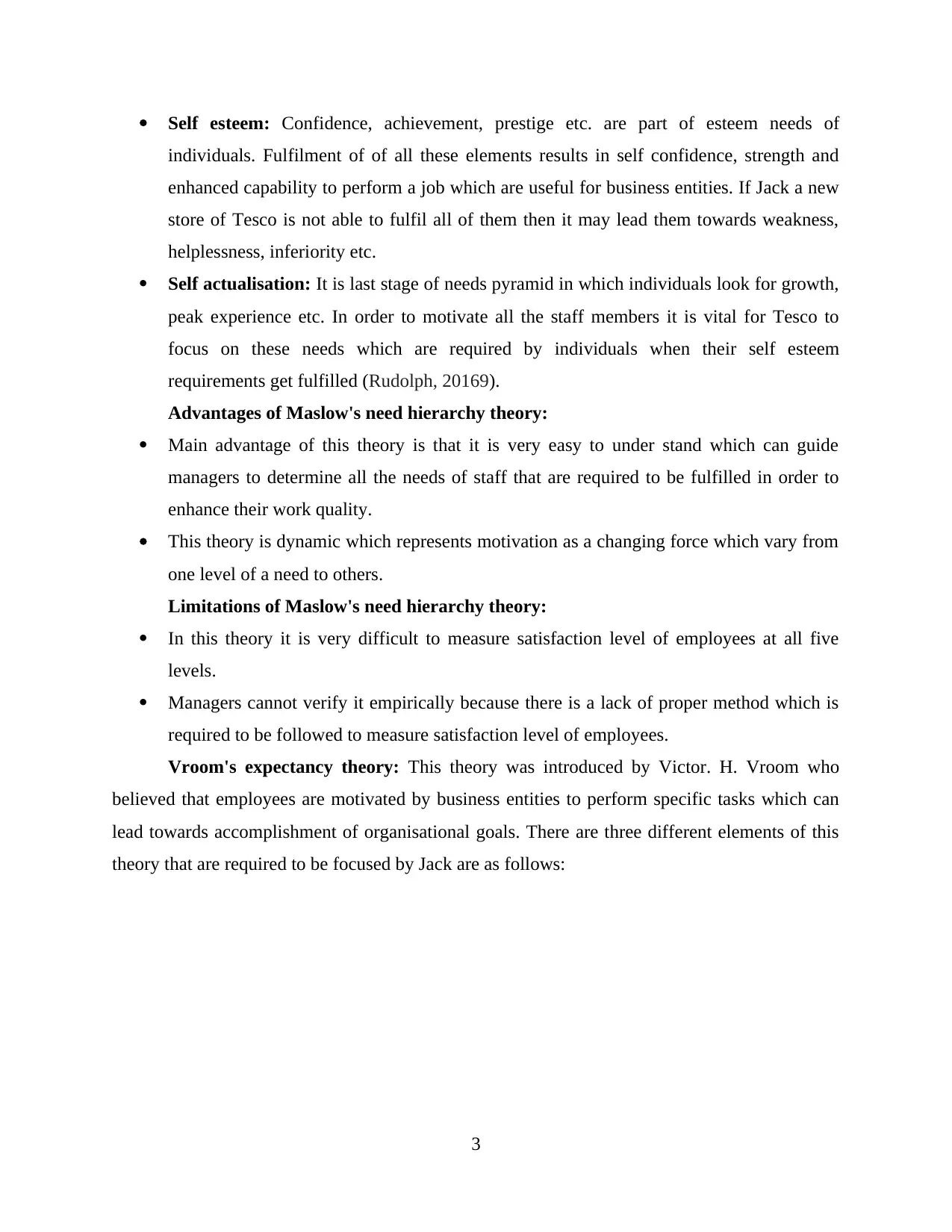
Self esteem: Confidence, achievement, prestige etc. are part of esteem needs of
individuals. Fulfilment of of all these elements results in self confidence, strength and
enhanced capability to perform a job which are useful for business entities. If Jack a new
store of Tesco is not able to fulfil all of them then it may lead them towards weakness,
helplessness, inferiority etc.
Self actualisation: It is last stage of needs pyramid in which individuals look for growth,
peak experience etc. In order to motivate all the staff members it is vital for Tesco to
focus on these needs which are required by individuals when their self esteem
requirements get fulfilled (Rudolph, 20169).
Advantages of Maslow's need hierarchy theory:
Main advantage of this theory is that it is very easy to under stand which can guide
managers to determine all the needs of staff that are required to be fulfilled in order to
enhance their work quality.
This theory is dynamic which represents motivation as a changing force which vary from
one level of a need to others.
Limitations of Maslow's need hierarchy theory:
In this theory it is very difficult to measure satisfaction level of employees at all five
levels.
Managers cannot verify it empirically because there is a lack of proper method which is
required to be followed to measure satisfaction level of employees.
Vroom's expectancy theory: This theory was introduced by Victor. H. Vroom who
believed that employees are motivated by business entities to perform specific tasks which can
lead towards accomplishment of organisational goals. There are three different elements of this
theory that are required to be focused by Jack are as follows:
3
individuals. Fulfilment of of all these elements results in self confidence, strength and
enhanced capability to perform a job which are useful for business entities. If Jack a new
store of Tesco is not able to fulfil all of them then it may lead them towards weakness,
helplessness, inferiority etc.
Self actualisation: It is last stage of needs pyramid in which individuals look for growth,
peak experience etc. In order to motivate all the staff members it is vital for Tesco to
focus on these needs which are required by individuals when their self esteem
requirements get fulfilled (Rudolph, 20169).
Advantages of Maslow's need hierarchy theory:
Main advantage of this theory is that it is very easy to under stand which can guide
managers to determine all the needs of staff that are required to be fulfilled in order to
enhance their work quality.
This theory is dynamic which represents motivation as a changing force which vary from
one level of a need to others.
Limitations of Maslow's need hierarchy theory:
In this theory it is very difficult to measure satisfaction level of employees at all five
levels.
Managers cannot verify it empirically because there is a lack of proper method which is
required to be followed to measure satisfaction level of employees.
Vroom's expectancy theory: This theory was introduced by Victor. H. Vroom who
believed that employees are motivated by business entities to perform specific tasks which can
lead towards accomplishment of organisational goals. There are three different elements of this
theory that are required to be focused by Jack are as follows:
3
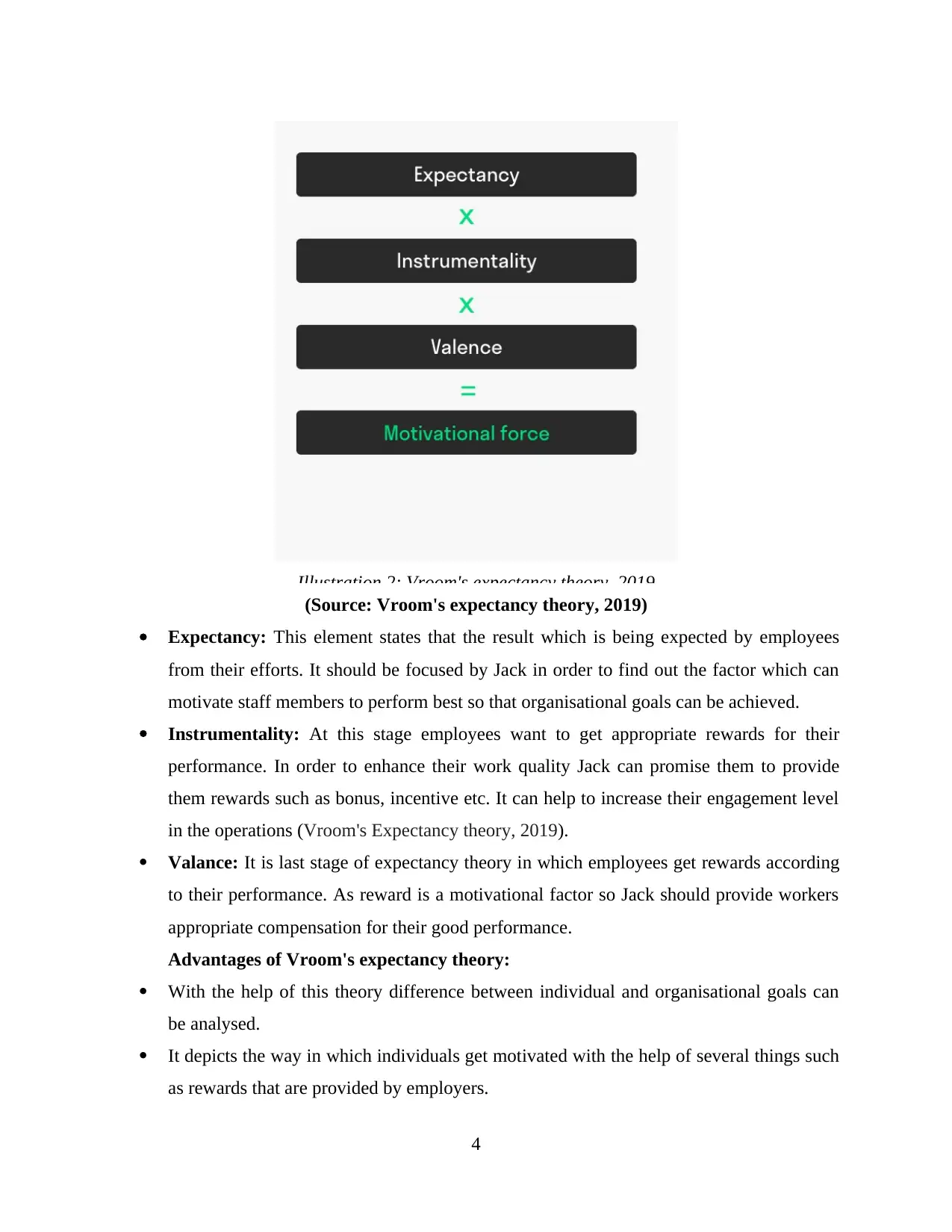
Illustration 2: Vroom's expectancy theory, 2019
(Source: Vroom's expectancy theory, 2019)
Expectancy: This element states that the result which is being expected by employees
from their efforts. It should be focused by Jack in order to find out the factor which can
motivate staff members to perform best so that organisational goals can be achieved.
Instrumentality: At this stage employees want to get appropriate rewards for their
performance. In order to enhance their work quality Jack can promise them to provide
them rewards such as bonus, incentive etc. It can help to increase their engagement level
in the operations (Vroom's Expectancy theory, 2019).
Valance: It is last stage of expectancy theory in which employees get rewards according
to their performance. As reward is a motivational factor so Jack should provide workers
appropriate compensation for their good performance.
Advantages of Vroom's expectancy theory:
With the help of this theory difference between individual and organisational goals can
be analysed.
It depicts the way in which individuals get motivated with the help of several things such
as rewards that are provided by employers.
4
(Source: Vroom's expectancy theory, 2019)
Expectancy: This element states that the result which is being expected by employees
from their efforts. It should be focused by Jack in order to find out the factor which can
motivate staff members to perform best so that organisational goals can be achieved.
Instrumentality: At this stage employees want to get appropriate rewards for their
performance. In order to enhance their work quality Jack can promise them to provide
them rewards such as bonus, incentive etc. It can help to increase their engagement level
in the operations (Vroom's Expectancy theory, 2019).
Valance: It is last stage of expectancy theory in which employees get rewards according
to their performance. As reward is a motivational factor so Jack should provide workers
appropriate compensation for their good performance.
Advantages of Vroom's expectancy theory:
With the help of this theory difference between individual and organisational goals can
be analysed.
It depicts the way in which individuals get motivated with the help of several things such
as rewards that are provided by employers.
4
⊘ This is a preview!⊘
Do you want full access?
Subscribe today to unlock all pages.

Trusted by 1+ million students worldwide
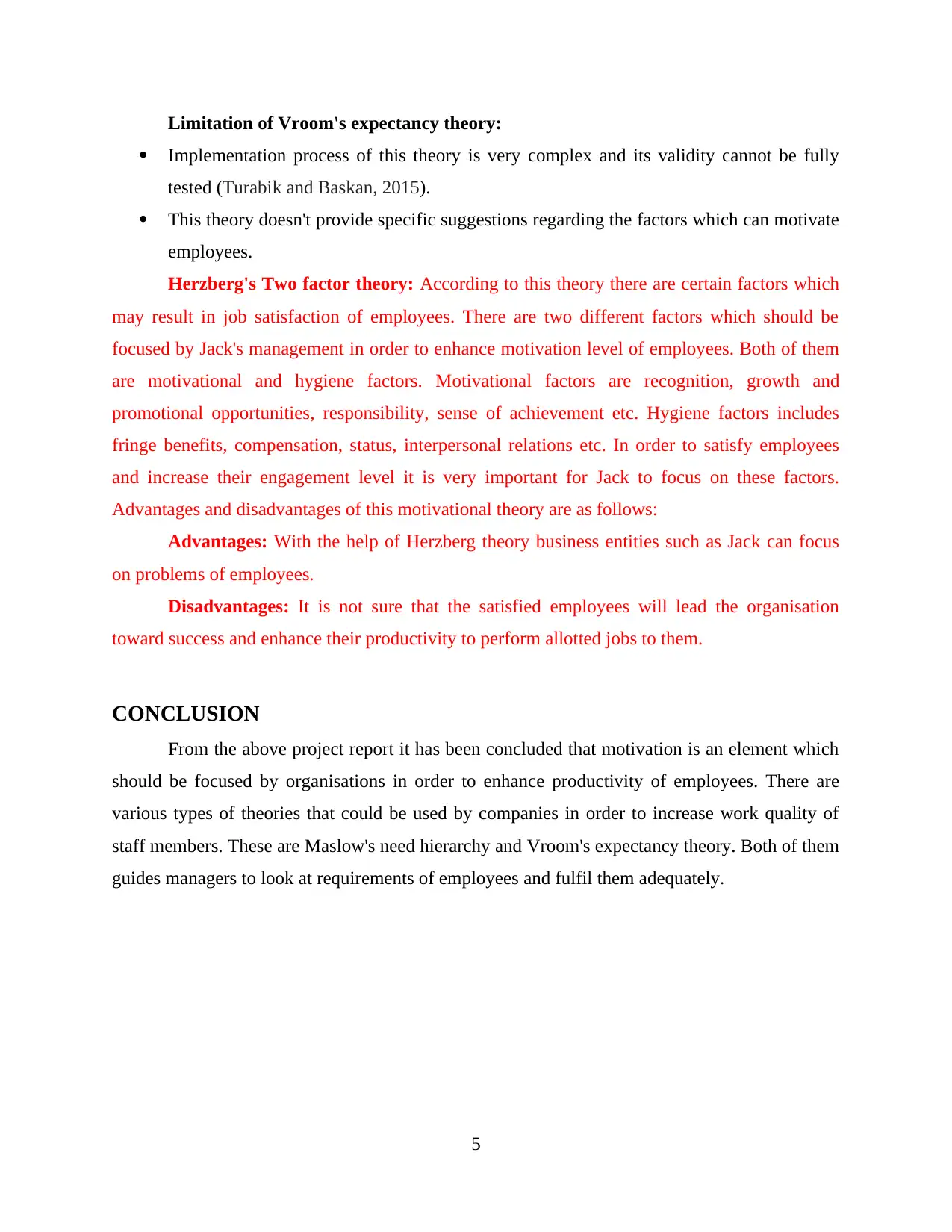
Limitation of Vroom's expectancy theory:
Implementation process of this theory is very complex and its validity cannot be fully
tested (Turabik and Baskan, 2015).
This theory doesn't provide specific suggestions regarding the factors which can motivate
employees.
Herzberg's Two factor theory: According to this theory there are certain factors which
may result in job satisfaction of employees. There are two different factors which should be
focused by Jack's management in order to enhance motivation level of employees. Both of them
are motivational and hygiene factors. Motivational factors are recognition, growth and
promotional opportunities, responsibility, sense of achievement etc. Hygiene factors includes
fringe benefits, compensation, status, interpersonal relations etc. In order to satisfy employees
and increase their engagement level it is very important for Jack to focus on these factors.
Advantages and disadvantages of this motivational theory are as follows:
Advantages: With the help of Herzberg theory business entities such as Jack can focus
on problems of employees.
Disadvantages: It is not sure that the satisfied employees will lead the organisation
toward success and enhance their productivity to perform allotted jobs to them.
CONCLUSION
From the above project report it has been concluded that motivation is an element which
should be focused by organisations in order to enhance productivity of employees. There are
various types of theories that could be used by companies in order to increase work quality of
staff members. These are Maslow's need hierarchy and Vroom's expectancy theory. Both of them
guides managers to look at requirements of employees and fulfil them adequately.
5
Implementation process of this theory is very complex and its validity cannot be fully
tested (Turabik and Baskan, 2015).
This theory doesn't provide specific suggestions regarding the factors which can motivate
employees.
Herzberg's Two factor theory: According to this theory there are certain factors which
may result in job satisfaction of employees. There are two different factors which should be
focused by Jack's management in order to enhance motivation level of employees. Both of them
are motivational and hygiene factors. Motivational factors are recognition, growth and
promotional opportunities, responsibility, sense of achievement etc. Hygiene factors includes
fringe benefits, compensation, status, interpersonal relations etc. In order to satisfy employees
and increase their engagement level it is very important for Jack to focus on these factors.
Advantages and disadvantages of this motivational theory are as follows:
Advantages: With the help of Herzberg theory business entities such as Jack can focus
on problems of employees.
Disadvantages: It is not sure that the satisfied employees will lead the organisation
toward success and enhance their productivity to perform allotted jobs to them.
CONCLUSION
From the above project report it has been concluded that motivation is an element which
should be focused by organisations in order to enhance productivity of employees. There are
various types of theories that could be used by companies in order to increase work quality of
staff members. These are Maslow's need hierarchy and Vroom's expectancy theory. Both of them
guides managers to look at requirements of employees and fulfil them adequately.
5
Paraphrase This Document
Need a fresh take? Get an instant paraphrase of this document with our AI Paraphraser
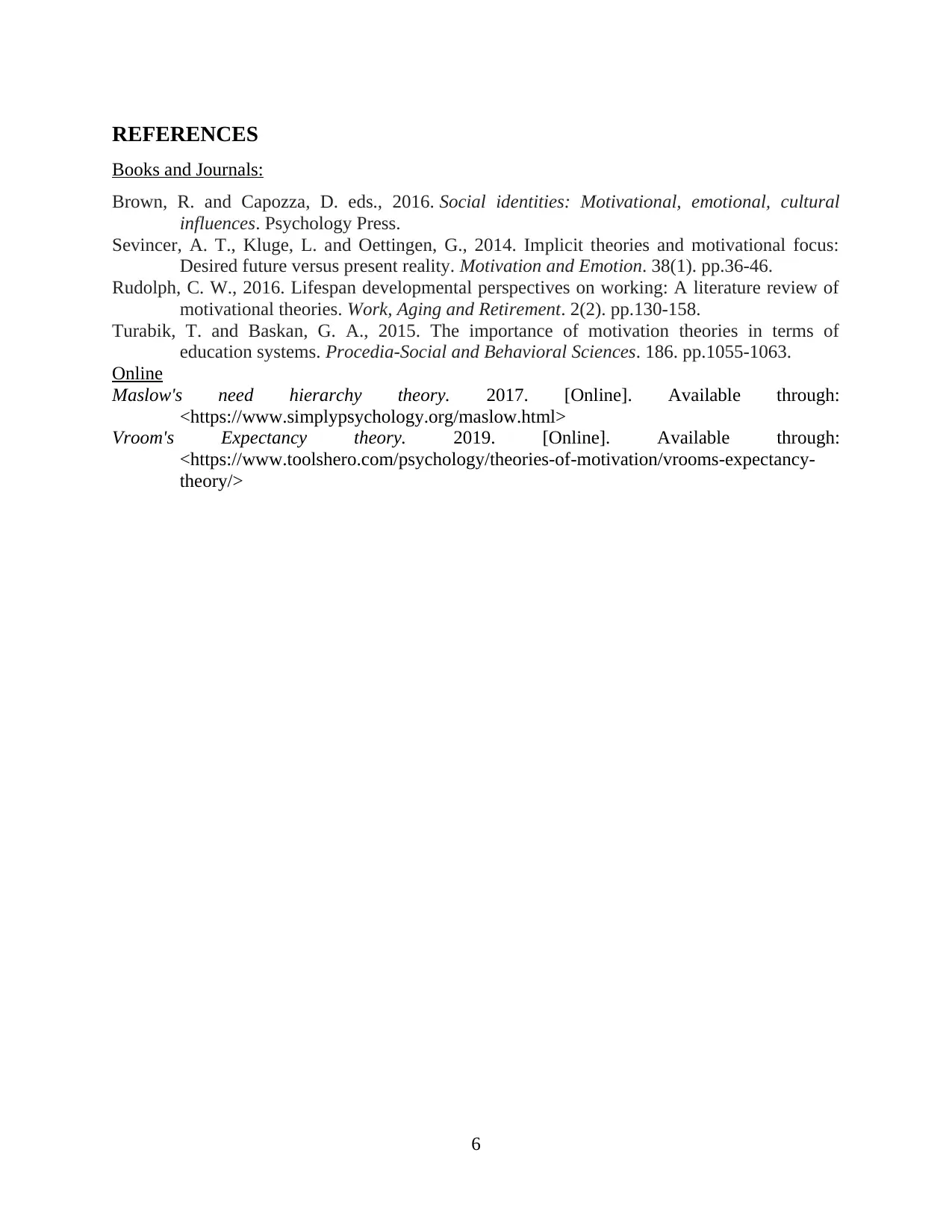
REFERENCES
Books and Journals:
Brown, R. and Capozza, D. eds., 2016. Social identities: Motivational, emotional, cultural
influences. Psychology Press.
Sevincer, A. T., Kluge, L. and Oettingen, G., 2014. Implicit theories and motivational focus:
Desired future versus present reality. Motivation and Emotion. 38(1). pp.36-46.
Rudolph, C. W., 2016. Lifespan developmental perspectives on working: A literature review of
motivational theories. Work, Aging and Retirement. 2(2). pp.130-158.
Turabik, T. and Baskan, G. A., 2015. The importance of motivation theories in terms of
education systems. Procedia-Social and Behavioral Sciences. 186. pp.1055-1063.
Online
Maslow's need hierarchy theory. 2017. [Online]. Available through:
<https://www.simplypsychology.org/maslow.html>
Vroom's Expectancy theory. 2019. [Online]. Available through:
<https://www.toolshero.com/psychology/theories-of-motivation/vrooms-expectancy-
theory/>
6
Books and Journals:
Brown, R. and Capozza, D. eds., 2016. Social identities: Motivational, emotional, cultural
influences. Psychology Press.
Sevincer, A. T., Kluge, L. and Oettingen, G., 2014. Implicit theories and motivational focus:
Desired future versus present reality. Motivation and Emotion. 38(1). pp.36-46.
Rudolph, C. W., 2016. Lifespan developmental perspectives on working: A literature review of
motivational theories. Work, Aging and Retirement. 2(2). pp.130-158.
Turabik, T. and Baskan, G. A., 2015. The importance of motivation theories in terms of
education systems. Procedia-Social and Behavioral Sciences. 186. pp.1055-1063.
Online
Maslow's need hierarchy theory. 2017. [Online]. Available through:
<https://www.simplypsychology.org/maslow.html>
Vroom's Expectancy theory. 2019. [Online]. Available through:
<https://www.toolshero.com/psychology/theories-of-motivation/vrooms-expectancy-
theory/>
6
1 out of 8
Related Documents
Your All-in-One AI-Powered Toolkit for Academic Success.
+13062052269
info@desklib.com
Available 24*7 on WhatsApp / Email
![[object Object]](/_next/static/media/star-bottom.7253800d.svg)
Unlock your academic potential
Copyright © 2020–2025 A2Z Services. All Rights Reserved. Developed and managed by ZUCOL.





